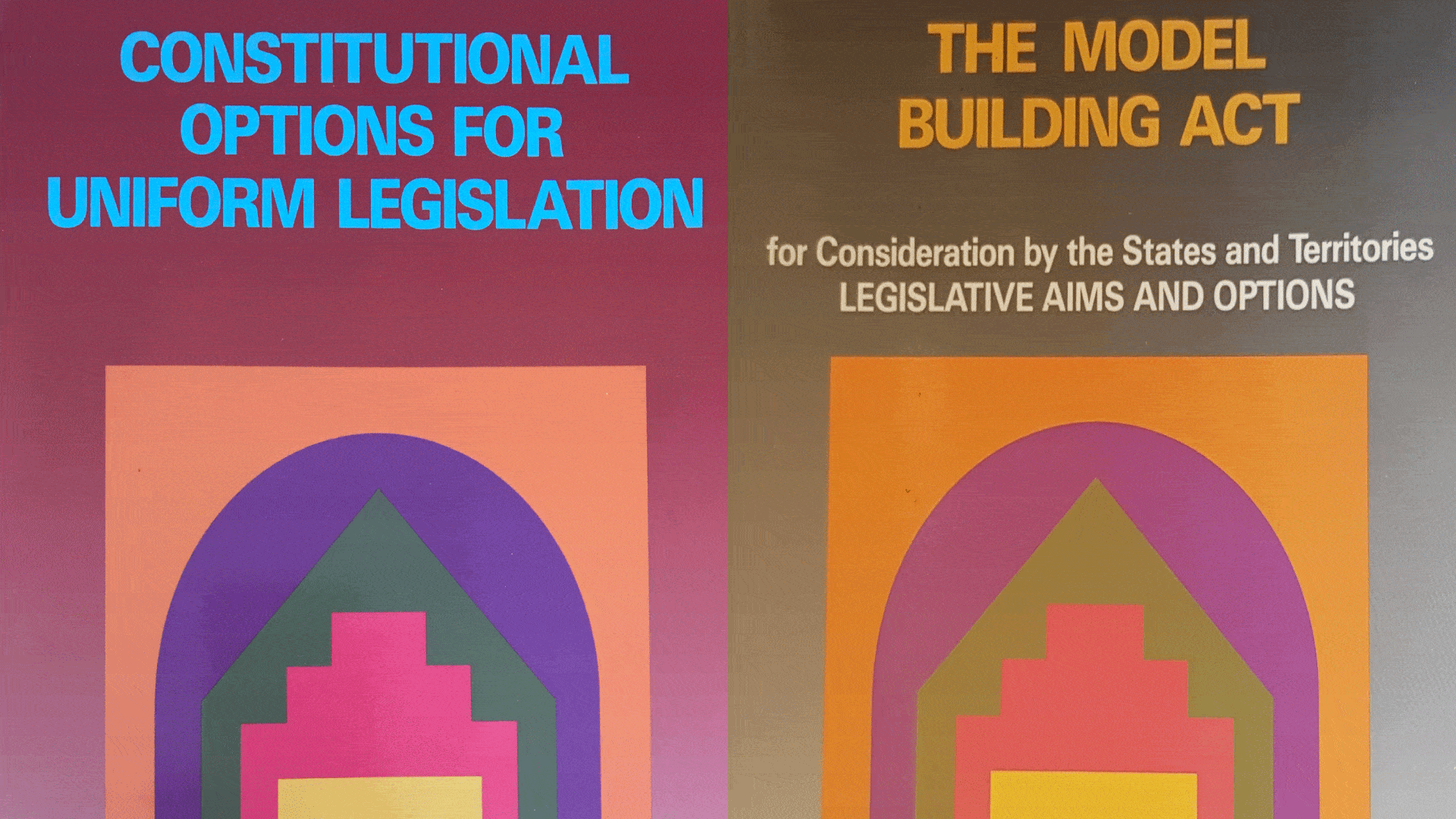2023 Marks the 30-year Anniversary of the Victorian Building Act 1993.

2023 marks the 30-year anniversary of the Victorian Building Act 1993. It replaced holus bolus the Building Control Act 1991.
It was the ‘filial derivative’ of the National Model Building Act that was published by the Australian Uniform Building Regulatory Coordinating Council (the predecessor of the ABCB).
A pioneering and game changing act of parliament
Pioneering along with the Northern Territory Building Act 1993, both pieces of legislation introduced new Model Building Act inspired concepts being:-
- 10 year liability limitation periods
- Proportionate liability periods
- Compulsory insurance
- Mandatory registration of key actors
- Private certification
- Broad church registration of key actors
- A centralised mission control for building regulation; the Building-Control Commission


Proportionate liability replaced joint and several liability
The National Model Building Act inspired the proportionate liability mechanism which ousted the operation of Joint and Several Liability. The Building Act introduced section 131, the first ever proportionate liability provision in the country. Section 131 dictated that liability for building fault had to be apportioned amongst the key actors responsible for the fault in a manner commensurate with their contribution or authorship of the fault.
131 Limitations on liability of persons jointly or severally liable
(1) After determining an award of damages in a building action, the court must give judgment against each defendant to that action who is found to be jointly and severally liable for damages for such proportion of the total amount of damages as the court considers just and equitable having regard to the extent of that defendant’s responsibility for the loss and damage.
(2) Despite any Act or rule of law to the contrary, the liability for damages of a person found to be jointly or severally liable for damages in a building action is limited to the amount for which judgment is given against that person by the court.
The now replaced section 131 of the Building Act 1993 (Vic)
Simply put, responsibility lies with the party responsible for the fault; a compellingly equitable doctrine. Section 131 has been repealed and it’s jurisdiction consumed by the Wrongs Act 1958 section 24AI.
Rationale for the Reform and Problem Statement

Joint and Several Liability provides that:-
- The solvent defendant is at risk of assuming the liability of insolvent co-defendants or 3rd parties joined.
- So if there are multi-defendant co-‘implicatees’ in a legal proceeding when the judicial determination is handed down and some remain solvent but other parties have become insolvent defendants, the solvent concerns assume the liability of the impecunious.
- Hence terms like the ‘deep pocket syndrome’ or in the case of local government ‘insurers of last resort’ were coined.
The problem was the fundamentally unfair and inequitable concept of joint and several liability where the solvent have to assume liability for co-responsible actors. In a sense they are the victims of their own solvency.
The remedy
Proportionate liability is a concept where no party is compelled to assume the liability of another in circumstances where solvent and insolvent actors alike are responsible for a common fault.
So in a multi-defendant legal proceeding where let`s say five defendants are held liable, each defendant will be found liable for their apportioned contribution and no defendant will be responsible for payment of the adjudicated quantum of another – regardless of solvency.
Compulsory insurance for key actors
Coinciding with the introduction of proportionate liability was the introduction of compulsory insurance.
Problem statement
The concern that advocates have with respect to the importance of maintaining joint and several liability is the idea that joint and several liability ensures that ‘the last man standing’ ie; solvent defendants will underwrite and in a de facto sense indemnify the liabilities of the impecunious.
Further absent the operation of joint and several liability, the consumer would be at risk of becoming a “pyric victor” where the win does not translate into financial redress.
The problem with this thesis is that it assumes that there is at least one solvent defendant in the line-up of actors responsible, this is by no means is a given.
Secondly the assumption of the financial liabilities of the impecunious could in itself visit upon the solvent too onerous a liability which could in itself prejudice the solvency of an otherwise viable concern.
Having said that, to introduce proportionate liability in circumstances where there is no compulsory safety net, could in itself remove the “ostensibly” viable joint and several liability safety net.
The Remedy
The promulgation of proportionate liability with mandatory insurance for key actors. The Building Act did that as the following were required to be insured by law:-
- Building surveyors and building inspectors
- Architects
- Residential builders
- Draftspersons (prior to promulgation of the act there was no registered class of draftsperson)
- Quantity surveyors
- And engineers
Net effect, the introduction of a broad-church insurance regime complemented by proportionate liability resulting in an equitable risk landscape where responsibility and financial accountability lie with the responsible actors.
Compulsory Registration and licensing of Key Actors
Compulsory annual registration of key actors was then introduced where all building practitioners were required by law to be registered.
Apart from the regulated qualification and registration requirements evidence of compulsory cover was another registration precondition.
The then Building Practitioners Board was the government controlled registration body. This role has now been subsumed by the Victorian Building Authority.
Proportionate liability, compulsory insurance, and registration were all part of a holistic synergy, interdependent upon one another to ensure that there was superior consumer protection and a fairer risk landscape.
Of course, the registration body was the gate-keeper for setting registration entry requirements and also was the oversight body endowed with investigative, disciplinary, and ultimately, expulsion powers.
Prior to the Building Act no such centralised body existed nor was there any requirement for mandatory professional indemnity cover.
10 year liability capping
The Building Act heralded the introduction of 10 year liability capping.

Rationale and Problem statement
Before the 10 year cap was introduced there was uncertainty about when the six year limitation of actions act liability period started to run:
- One line of legal authorities stated from when the damage occurs
- The other line paid homage to the from when the damage is discernible (infinity plus six)
- This culminated in unnecessary litigation and forensics to figure out when the damage occurred; a fraught concept at the best of times.
The test was not clear and was risk ridden as outcome was case by case circumstantially dependant.
The Remedy:
10 year liability capping
This was French inspired and hailed from the liability decennial concept in the Napoleonic Code. The reason why we introduced this reform was to remove the uncertainty that was associated with the liability trigger date for the initiation of legal proceedings for building actions.
The 10 year liability cap achieved this by introducing a mechanism where the 10 year period starts to run from the date of issue of the occupancy permit or the certificate of final inspection. 10 years hence, the ability to sue is (to use French vernacular) “guillotined”.
And it was the cure, no more argument about which line of legal authority took precedence and in what month and what year did the damage occur, or who or when was it was first discovered by.
A Privatised alternative to the issue of building permits
Prior to the Building Act only councils could issue building permits, the Building Act heralded the private certification profession.
Rationale and problem statement
There was concern back in the day that councils took too long to issue building permits and the delays negatively impacted upon consumers and constructors alike.
It was considered that the introduction of a privatised alternative to permit issue would courtesy of competition expedite building permit delivery.
The verdict
There is no doubt that private certification has expedited building permit delivery times. But this has proved to be the most controversial of all of the reforms because a perception has emerged that the certifiers in many instances were not sufficiently arms-length from the fee paying client to remain truly detached. This writer will not venture into the debate as that is a thesis in itself, but it would be remiss to not mention that this reform has it’s advocates and it’s detractors in equal measure.
Yet is has survived 30 years while being legislatively revoked in New Zealand round about 2008, so it has proved resilient in Australia, despite the controversy that surrounds it. But there would be many that would say the ‘jury`s still out’.
Key take outs
The liability and insurance reforms were game changers, have been very well received and although not perfect, have significantly advanced consumer protection when compared to the previous era.
Some insurance is better than no insurance and mandatory insurance is better than optional insurance from a consumer perspective. Further compulsory insurance generates a critical mass of insurance premium which encourages insurer participation.
The prospect of consumers having no redress to insurance at the end of a costly and lengthy trial is morbid when one factors in the real prospect of insolvency being visited upon culpable parties.
The equitable allocation of risk that is part and parcel of proportionate liability ensures that the solvent aren’t victimised by the vagaries and heavy burdens that are central factors of joint and several liability. Better for the insurer to bear the burden than the municipal rate payer; after all the insurer is paid a premium to underwrite risk and that is their business. It is not the business of local government to underwrite the consumer for third party unknowns for their impecuniosity.
The writer in recent years has been retained by the World Bank to advise reforming jurisdictions on best practice regulatory constructs. The liability and insurance regime under the NMBA inspired and Victorian adopted reforms are always proffered as exemplars.
With regards to private certification, the writer says look to Japan where he has been verily informed that a key ingredient that underwrites the success of that system is mandatory and annual auditing of certifiers. He also does not advocate the adoption of private certification in emerging economies.
Conclusion
30 years on, the key reforms have proved to be keepers, revolutionary at the time they culminated in a new regime that displays all the hall marks of a system that will be here to stay. Although I somehow doubt whether I will be able to attest to this optimism 30 as my mortal remit will no doubt have expired.
This is a Lovegrove and Cotton publication.
Disclaimer
This article is not legal advice and discusses it’s topic in only general terms. Should you be in need of legal advice, please contact a construction law firm. The experienced team at Lovegrove & Cotton can help property owners and building practitioners resolve any type of building dispute.
